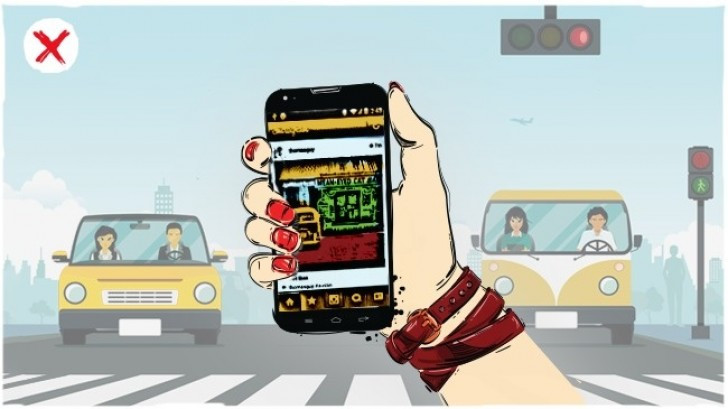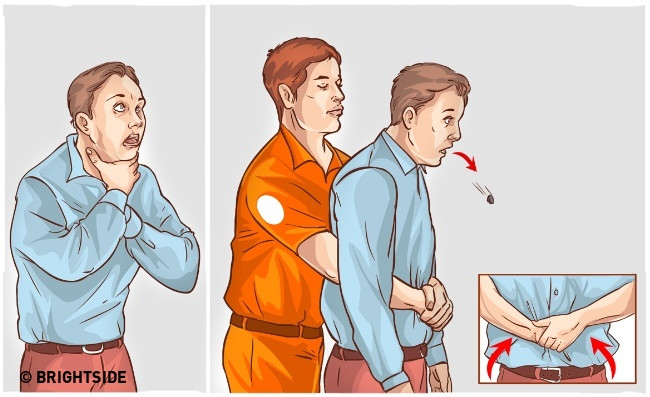14 simple facts that can save your life at any time
Those of us who are also in the care of some safety rules to save our lives in life. However, sometimes there are unexpected situations that make us confused.
So you need to be really calm, remember and apply these facts to save yourself with unforeseen difficulties.
1. Don't just go and use your mobile phone

Many studies have shown that going and using mobile phones will be a big challenge for the brain. This will make you more distracted, become "blind" to your surroundings.
And you know, concentration can lead to serious traffic accidents. So, don't just go (drive) and use your phone !
2. Create a strong impact on the back to push the object out
The Heimlich procedure is used to provide emergency care when a foreign object enters the airway and nearly occupies the entire area of the airway. Heimlich's principle is to create a powerful force, abruptly entering the 2 lung chambers by flapping from the back or pressing against the diaphragm, the goal of creating a sudden pressure in the respiratory tract to push the object out.

Steps:
- In order for the patient to stand, he leaned forward, the emergency person stood behind him, his hands wrapped around his abdomen on his stomach.
- Using his whole body, he jerked from front to back and from bottom to top to increase the pressure in his chest to remove the object.
- Repeat this action quickly and decisively until the object pops out.
If you are alone, push yourself to your stomach by standing with your back against a flat wall. Then, use a clenched fist, close the thumb and forefinger to the upper abdomen, just below the sternum (palm facing down).
Take the other fist to punch hard on the fist on the stomach in the direction from front to back and from bottom to bottom one by one. If the object does not come out, use a chair based on the belly above the navel to the top of the back plate. Then use the weight of the body to bend down into a chair to push the air from the inside, the object will be shot out.
3. Always carry anti-allergy medicine

Not only when using food, but even changing the abnormal weather from hot to cold or vice versa: changing the direction of wind, rain . is also an opportunity for allergies to develop, especially with people with allergic sites.
Therefore, you should always bring with you anti-allergy medication to protect yourself before the disease outbreak is strong. When a rash occurs, the patient may have difficulty breathing, rapid and sudden drop in blood pressure, affecting health.
4. Always remember the limits of human tolerance

"Rule 3" is one of the famous theories about the limits of endurance of the human body.
It is that we cannot hold our breath for more than 3 minutes, cannot stop drinking for more than 3 days and cannot fast for more than 3 weeks.
5. Cover pot and pan when cooking oil burns

When the oil was boiling on the stove caught fire, many people used water to pour into the pot and pan to put out the fire. This is a fatal mistake because it will cause the fire to burn higher and even shoot at you.
The correct treatment in this case is to cut off the supply of oxygen to the flame by turning off the stove and closing it again. In the absence of this, you can use a large, thick piece of cloth instead.
6. Do not remove knives / sharp objects from a seriously stabbed wound

According to health experts, you should not remove the stick / stake from the victim because doing so may cause the rod / stake to cause more damage or increase the risk of bleeding.
The thing to do is try to fix the object that hit the victim and then quickly bring the patient to the nearest medical facility.
7. Be especially careful the first 3 minutes after takeoff and the last 8 minutes before landing

In the field of aviation, people often mention the first 3 minutes after takeoff and the last 8 minutes before landing.
According to investigators, nearly 80% of aircraft accidents occurred during this period. Between these times, that is, when the plane is flying, the chance of a plane crash is negligible. So if you want to have a chance to survive then you need to be alert and ready to act in the first 3 minutes and 8 minutes.
8. Do not inflate the life jacket when in an airplane

Life jackets are used in emergencies when aircraft land in the sea. You should not inflate your life jacket while in an airplane, but wait until the quick exit door snatches the red card or blows the life jacket up.
These life jackets will help you survive if the plane crashed and fell into the sea. Life jackets are usually stored in a bag under the chair or a compartment next to the chair.
9. If you are "cranked" in a fire, try to move as close to the ground as possible

Smoke is one of the main reasons many people die in fires. Specifically, a lot of toxic gases will be produced CO 2 , CO, ammonia, organic acids . in which CO 2 and CO are the main causes of death.
Moving methods will also help you avoid the risk of smoke poisoning - that is, crawling, crawling, or bending low. That's because smoke only rises above, and the floor is the place with the least smoke.
10. If you suddenly feel unwell in a public place, just ask a help person

Remember, to avoid the psychological effect - diffuse responsibility so when you need help, you should only ask one person.
Why? Because when many people listen to a help, the responsibility to respond to that help no longer focuses on a certain individual but is divided among others. They feel it is not necessary that they help the victims, there are many people here, there will be helpers.
11. Always carry a flashlight

Flashlight is one of the things that you can use in more things than you can expect, and it's sad if you don't have one at the right time.
For example, when there is an unexpected ambush in the dark or harassed . you can shine a flashlight on the opponent's face, causing them to be dazzled and disoriented. From there, you can quickly run away.
12. Remember the basic rules in case of a fire

When the "fire lady" attacked, people were often panicked and had little time to think. It is this psychology that makes the victim not alert enough to observe the escape route.
Therefore, an important factor for people to escape the fire is to calm down, and perform the escape skills properly.
In addition, you should also check and observe the emergency exit map in any building to be able to shape the best travel direction. It's best to mind this first and don't wait for an emergency to happen!
13. Bring personal identification with you

Make sure you always bring with you some identification - maybe your identity card, medical information documents (like blood type, often allergic to what ingredients .) or Phone numbers for relatives to notify in an emergency.
Why? By this way when something unexpected happens, the information about you will be well-informed by the police, the hospital to take measures as well as the fastest notice to relatives.
14. Eliminate blind spots while driving by adjusting the mirror

Correctly adjusting the rearview mirror in the vehicle, the right position will help you remove the blind spot behind the vehicle because there will be a small area of overlapping observation area between the mirrors.
So, sit in the driver's seat, adjust the rearview mirror in the car so that you see the rear window in the center of the mirror.
When driving, notice that the rear-end vehicle will start from the rear mirror. When it comes close, it goes to the left (or right), and appears in the corresponding rearview mirror.
- Predict your life expectancy through a simple test
- 30 facts about sleep
- 10 mysteries about time (I)
- 7 facts about the Earth that many of us have not yet updated
- Simple ways to live long
- 10 mysteries about time (II)
- Learn about Time
- 6 historical facts make you lose completely the concept of time
- 7 facts about time everyone needs to know to control it
- How much time do you have in your life?
- These images will make you rethink your time in your life
- 10 interesting facts not everyone knows about the movie world
 'Fine laughs' - Scary and painful torture in ancient times
'Fine laughs' - Scary and painful torture in ancient times The sequence of numbers 142857 of the Egyptian pyramids is known as the strangest number in the world - Why?
The sequence of numbers 142857 of the Egyptian pyramids is known as the strangest number in the world - Why? History of the iron
History of the iron What is alum?
What is alum?